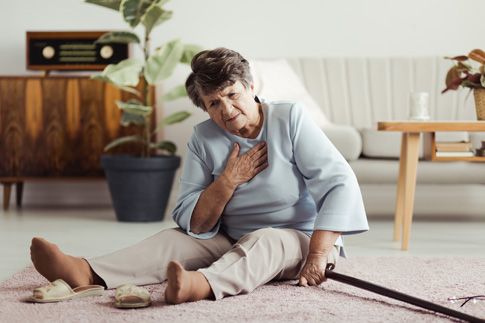 Each year more than one-third of adults 65 years and older fall. Of these falls, 20 to 30 percent result in injuries that reduce mobility. Men and women over 75 who have fallen are four to five times more likely to end up needing the extra assistance provided in a nursing home and experience at least temporary loss of some independence. These can be scary statistics as we get older. However, there are many things we can do to lower our risk of falling, to improve our balance and to remain independent longer.
Each year more than one-third of adults 65 years and older fall. Of these falls, 20 to 30 percent result in injuries that reduce mobility. Men and women over 75 who have fallen are four to five times more likely to end up needing the extra assistance provided in a nursing home and experience at least temporary loss of some independence. These can be scary statistics as we get older. However, there are many things we can do to lower our risk of falling, to improve our balance and to remain independent longer.
It is rare that falls are strictly accidental. There are causes associated with falls. There are reasons why one person ends up falling and another simply stumbles. The National Institute on Aging has some suggestions for lowering the chances of falling.
- Begin a plan for regular exercise to improve strength, balance and flexibility. Increasing muscle tone and keeping joints, ligaments and tendons mobile can help keep a person upright and stable. Consult your physician for exercises that would work best for you and consider joining an appropriate exercise program being offered in your community, such as the MU Extension programs A Matter of Balance or Stay Strong, Stay Healthy.
- Have vision and hearing tested often. Both factor into stability and balance.
- Check medications for side effects of dizziness or having an effect on coordination. If such effects are likely, visit with your doctor and/or pharmacist to find something else to lessen the effect on balance.
- Limit the amount of alcohol consumed. Even a small amount of alcohol can negatively affect balance and the reflexes needed to avoid falling.
- Use a cane, walking stick or walker when walking in areas that may be unfamiliar or crowded or where walkways are uneven. Although these assistive devices might not be needed all the time, there are situations in which having such a device may make all the difference in terms of safety and stability.
- Wear rubber-soled, low-heeled shoes that support your feet and do not let them slip around. Wear shoes that have the traction needed to prevent sliding on smooth surfaces.
- Avoid icy, wet or leaf-covered surfaces as these can be very slippery. Spread sand or salt on icy surfaces if walking on them is necessary.
- Hold handrails when using the stairs. If carrying something, only carry what can be held in one hand so the other hand can be used for guidance and support on the handrail, even if that means making extra trips.
- Use a “reach stick” rather than standing on a chair or table to reach items that are too high.
Often there are areas and conditions in the home that create a higher risk of falling. Here is a checklist of some simple, common sense remedies from the National Institute on Aging for making your home a safer place.
In stairways, hallways and pathways:
- Make sure there is good lighting in walkways. Have light switches at the top and bottom of stairs, at both ends of long hallways, and near entrances to rooms.
- Keep areas where people walk clear of clutter and other tripping hazards.
- Make sure carpets are firmly fixed to the floor and do not slide when walked on. On tile or slick wooden floors, attach no-slip strips for traction.
- Have tightly fastened railings on both sides of stairs all the way from the top to the bottom.
- Use night lights in passageways to avoid having to move about in the dark.
In bathrooms:
- Mount grab bars near toilets and inside and outside of tubs and showers.
- Lay no-slip strips or non-skid carpets or mats in areas that may get wet.
- Wipe up spills right away.
- Keep night lights on.
In the bedroom:
- Place a light switch near the bed to avoid having to cross the room in the dark.
- Keep the telephone near the bed.
In other living areas:
- Keep electrical and phone cords near walls, behind furniture and out of the path where people walk.
- Make sure all carpets or rugs are secured to the floor, either by tacking them down or using non-skid strips underneath.
- Arrange furniture so there is plenty of free space to get around in each room. Pay close attention to legs that might stick out beyond the edge of the piece of furniture, corners that might catch a leg or side, and other protrusions.
- Select chairs and couches that are of a proper height for those using them, making it easy to get up and down. Make adjustments to existing seating areas by using pillows or cushions to achieve a good height – just be sure these aides do not slip out when getting in or out of the chair or couch.
Maintaining independence by preventing falls is often very attainable. Consider where the challenges are and find solutions that work for the individual.
For more ideas on assessing a home or defining the challenges, see if there is A Matter of Balance class in your area.